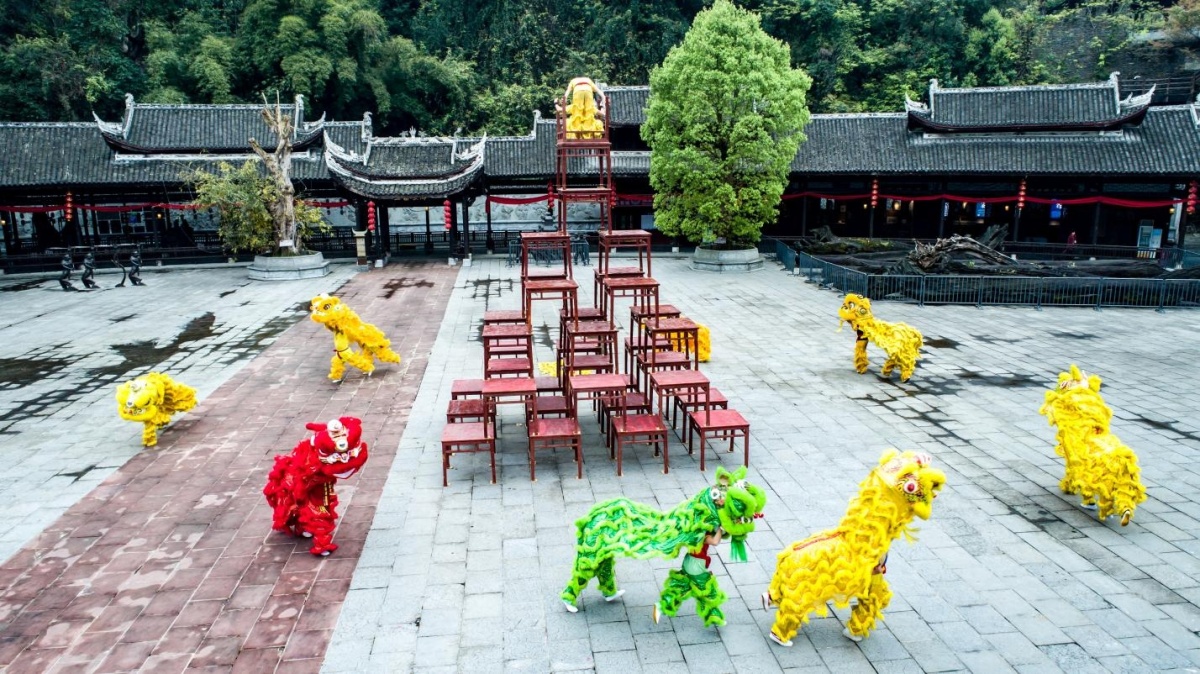Editor's Note: This article is produced in collaboration with the Chongqing Institute of Foreign Studies as part of a series of ongoing reports exploring the city's abundant resources in intangible cultural heritages.
“Qiang, Qiang, Qiang! Dong, Dong, Dong! ... One, two, three, jump! .......” The vibrant sounds resonate from the practice sessions of Pengshui Gaotai Lion Dancing. In the heart of Pengshui Miao and Tujia Autonomous County, southeastern Chongqing, the rhythmic gong beats echo through the mountains. Here, the Family Troupe of Tang stands out as a premier ensemble for the Pengshui Gaotai Lion Dance. They are more than performers; they are custodians of their heritage, offering lion dance training classes that ensure the art's daily practice and preservation.
Mao Yunfeng, a 38-year-old custodian of the national intangible cultural heritage, has spent 26 years perfecting the art of lion dancing. As a proud representative of the 17th generation of inheritors, he ascended to leadership during a multi-team lion dancing competition in the county’s gymnasium in 2016, marking his prominence as the new figurehead.
“To adapt to the development of our society and ensure the preservation of Gaotai Lion Dancing, we are opening our doors to society and schools, welcoming apprentices without time constraints,” declared Mao Yunfeng. His team currently boasts 26 members, of which a significant 70% are young individuals. The youngest member is merely 14 years old, a testament to the fact that lion dancing requires not just skill but also a significant degree of physical strength and stamina.
Regarded as an emblem of strength and prosperity, the lion is invoked to banish malevolent forces and repel evil spirits with hopes that it will usher in good fortune and well-being. Similarly, the Pengshui Gaotai Lion Dancing also conveys people’s wonderful wishes for a peaceful and tranquil life.

The performance of Pengshui's Gaotai Lion Dance (Photo/The Cultural Center of Pengshui Miao and Tujia Autonomous County)
Transitioning from ground to high platforms, the Pengshui Gaotai Lion Dancing retains traditional foundational performance techniques like standing, stepping, probing, and jumping. By seamlessly integrating these with contemporary movements drawn from martial arts and dance, it creates a bridge between the time-honored past and the dynamic present.
As time went by, the musical accompaniment for Gaotai Lion Dancing transitioned from purely folk-based to a fusion of folk and modern elements. It keeps abreast of the time and evokes the audience’s tense and exciting emotional resonance by playing contemporary music on a high platform piled by a dozen tables and stepping on the rhythms of drums.
“Before every performance, all of us will venerate our grand master together, and we uphold this ritual upon our return post-performance.” Mao Yunfeng said, “It’s a time-honored tradition we hold dear and cannot forget.”

The performance of Pengshui's Gaotai Lion Dance (Photo/The Cultural Center of Pengshui Miao and Tujia Autonomous County)
“We meticulously select the heights for our performances, and there’s a distinction between handmade and commercially purchased lion costumes,” Mao Yunfeng mentioned. The tables, essential for constructing the elevated stage, are fashioned from premium white oak. For stage stability, specific configurations of table amounts are maintained, including groupings of 3, 7, 9, 15, 24, and 36, with 36 being predominant. As the handmade lions are easily damaged if not stored properly, there’s a growing preference to adopt the commercially purchased ones for performance.
Mao's team showcases a diverse range of performances, from commercial and public displays to incorporating intangible cultural heritage in school curricula. While they have numerous engagements, the lack of consistent bookings leads to fluctuations in income.
Thanks to national policies aimed at preserving intangible cultural heritage, Pengshui Gaotai Lion Dancing achieved recognition as a national intangible cultural heritage in 2011.

The rehearsal of Pengshui's Gaotai Lion Dance (Photo/The Cultural Center of Pengshui Miao and Tujia Autonomous County)
Mao expressed a desire to showcase Gaotai Lion Dancing beyond the confines of Chongqing, bringing it to major events and attractions and into the broader public consciousness. The goal is to inspire more individuals to learn, safeguard, and perpetuate this national intangible cultural heritage, thereby making a meaningful impact on the promotion of national cultural evolution.
For over 150 years, Pengshui Gaotai Lion Dancing, which flourished during the mid to late Qing Dynasty, has been carried forward. It represents not just sentiment and culture but also a profound duty. With comprehension, dedication, and zeal, this intangible cultural heritage is poised to dazzle anew in our contemporary era.
Chinese script: Liao Shengyuan
Tutored by: Xu Li
Translation: Feng Lei
Tutored by: Wu Shulin Jiang Jun Ren Yi
Voice-over: Li Dan
Tutored by: Gui Shushu
